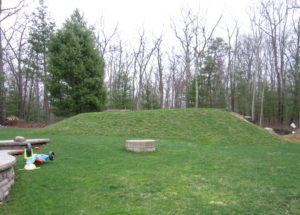Hello Fellow Readers,
Last week we shared Pam and Ed’s steep garden dilemma leading to the flat back forty where their septic field is. Ed thought it best not to plant anything over the field as the root systems could interfere. It’s true it’s not good to plant trees, large shrubs or water loving plants on a leach field. However, shallow rooted herbaceous plants that thrive without watering actually helps septic systems function more efficiently. They’ll help improve oxygen exchange and stimulate moisture elimination through transpiration. Turf grass is the go-to and for good reason. It holds the soil in place and it doesn’t require watering or fertilizing if you can control the urge for a perfect lawn. Overfertilizing or watering can negatively affect the microbial function of the soil impacting the breakdown of waste before harmful bacteria reaches the groundwater. Hence irrigation systems within 10-feet of leach fields is a no-no. As is heavy traffic causing soil compaction and plants or groundcovers that will heavily shade the area or collect debris.
Rather than grass, we decided on a native wildflower mix that touts xeriscape (meaning requiring little or no irrigation). The seeds will naturalize with the native weeds and grasses creating a meadow to blend into Pam & Ed’s surrounding woodland area much like the native phlox found on a slope along the side of the road (pictured above).
Nowadays new septic systems are often partially aboveground. Folks call them turkey mounds… not sure why. I thought the trend of these unsightly mounds had to do with installers taking the easy way out or they provide a less expensive option. It turns out mound systems are more expensive and have become common in areas with high groundwater or bedrock due to local laws and ordinances. Some feel it’s a conspiracy of sorts to maximize revenue for those involved in engineering and installing them. Mound systems are not only far costlier to install; they require an electrical pump to run; unlike the conventional gravity systems that are flat on your lawn.
My dear Curt thought the name turkey mound came from the opportunity to hide behind them while hunting for turkeys. Sounds logical. But might as well hide the “uglies” while you’re at it. Mixes of wildflowers, bulbs and grasses on top of a turkey mound will work wonders. Plant taller plants along the slope and shorter ones on top to help balance the look of the mound.
Garden Dilemmas? Askmarystone@gmail.com
Other tips:
It’s always best to test soil pH and use plants that are pH adaptable as soil pH can fluctuate on top of a leach field.
Although the drain field may seem ideal to plant veggies it’s not recommended as bacterial contamination may not be fully filtered out. Raised beds aren’t an option either due to the weight and impact on proper evaporation.
Trees with aggressive root systems near the field such as willows, birches, beeches, elms, poplars, and red and silver maples should be avoided. Trees with less aggressive roots such as dogwoods, hemlock, oaks, cherries, and crabapples can be planted 20-feet from the field. Keep nonaggressive shrubs at least 10 feet away.
Don’t add additional soil over the leach field and keep mulch at a minimum to not restrict evaporation.




